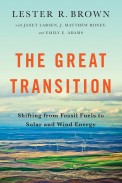Did you know? China is planting a belt of trees to protect land from the expanding Gobi Desert. This Great Green Wall is projected to extend some 4,480 kilometers (2,800 miles), stretching from outer Beijing through Inner Mongolia (Nei Monggol). Unfortunately, recent pressures to expand food production appear to have slowed this tree planting initiative. For more information view the text and data in Chapter 8 of Plan B 4.0: Mobilizing to Save Civilization.
Click here to view the most recent Fish Catch Indicator and Data
The world fish catch in 2000, the last year for which global data are available, was reported at 94.8 million tons. After decades of steady growth, the oceanic fish catch has plateaued and since the late 1980s has fluctuated between 85 million and 95 million tons. Some three fourths of oceanic fisheries are fished at or beyond their sustainable yields. In one third of these, stocks are declining.
Some scientists, when correcting for suspected overreporting by China, the world's leading fishing nation, believe that global catch has actually declined by 360,000 tons each year since 1988. When catch of the highly variable stocks of Peruvian anchovetas, a species substantially affected by El Niño/Southern Oscillation events, is excluded, the world fish catch appears to have declined by 660,000 tons a year during that time.
Recent evidence points to a rapid decline in production of the North Atlantic Ocean, where catches of many popular fish species, including cod, tuna, haddock, flounder, and hake, have dropped by half within the past 50 years, even though fishing efforts tripled. Previous infamous collapses, like that of the Newfoundland cod fishery, were local in scale, but this decline is ocean-wide.
At least $2.5 billion of government money goes to subsidize fishing in the North Atlantic each year, supporting incomes and paying portions of boat fuel and equipment bills. Worldwide, fishing subsidies total at least $15 billion, but may be substantially higher. In 1993, the U.N. Food and Agriculture Organization reported that the operating costs of fisheries around the world exceeded commercial revenues by over $50 billion each year. Without subsidies, the world's fishing industry would be bankrupt.
About 950 million people worldwide rely on fish as their primary source of protein. In addition, ocean fisheries and fish-related industries sustain the livelihoods of some 200 million people. These are high numbers to sustain on a bankrupt industry.
Subsidies hide the fact that current fishing practices are unsustainable, both economically and ecologically. Subsidy money has helped to build a technologically advanced global fishing fleet of over 23,000 ships weighing more than 100 tons each. Massive ships, such as trawlers, drag big nets—quickly catching large quantities of fish and bycatch. Some vessels have onboard processing facilities. Large ships consume a great deal of energy: it takes twice as much fuel to capture a ton of fish today as it did 20 years ago. Overall, the world's fishing fleet has the capacity to catch fish at more than twice the fisheries' sustainable yields.
As fish harvests from the ocean are steady or declining, production of fish from farms (aquaculture) is booming. Since 1990, aquaculture production has grown by almost 10 percent each year, more than twice the rate for poultry, the second fastest-growing sector of the animal protein economy. Total fish-farm production in 2000 was almost 36 million tons. In 1950, aquaculture provided less than 1 percent of the fish supply; now it accounts for a full 27 percent of the world fish market.
Growing fish in pens and ponds could reduce pressure on oceanic fisheries, but only if it is done wisely. A number of popular farmed fish, like salmon and shrimp, are carnivorous, requiring fish from the oceans to be harvested to provide fish meal and fish oil for their food. Some species require up to 5 kilograms of wild fish for each kilogram of fish produced. Harvesting fish for feed can empty oceans of smaller fish, depriving larger wild fish of their food supply.
China, which provides 23 million tons of the world aquaculture output, has farmed fish for thousands of years. It now devotes some 5 million hectares of land to farming primarily herbivorous fish. An additional 1.7 million hectares of rice paddies double as fish ponds. China has developed an innovative carp polyculture, in which several carp species with complementary feeding habits are grown together as they would in natural ecosystems.
China's onshore, integrated aquaculture and agriculture production system can serve as a model for aquaculturalists. Onshore production can minimize problems that plague marine aquaculture operations, such as coastal habitat destruction and excessive nutrient pollution, which can cause algal blooms. It also reduces the risk of introducing nonnative species through escapes and spreading diseases that fish in high-density confinement are prone to.
For a number of oceanic fisheries, a deliberate reduction of fishing, along with the development of "no-take" protected areas, is the only way for stocks to rebuild. Marine reserves have been shown to increase fish populations and diversity and to produce larger fish both within their boundaries as well as in commercially accessible waters. In a matter of a few years, a nearby off-limits area can revive a foundering fishery.
To protect wild stocks, consumers can reduce their overall fish consumption, or at least purchase responsibly produced herbivorous fish or those caught from well-managed fisheries. The Marine Stewardship Council, an independently operated international accreditation organization, has certified six fisheries as sustainable. Careful management of fisheries can be likened to prudent use of an endowment: if the principal, or the stock, is conserved, people can live off the interest indefinitely.
Copyright © 2002 Earth Policy Institute


 Print:
Print:  Email
Email

